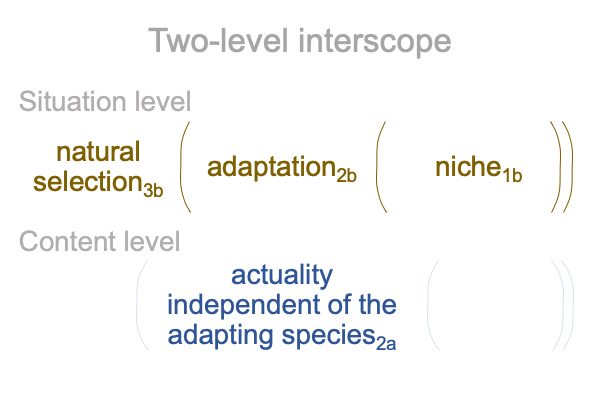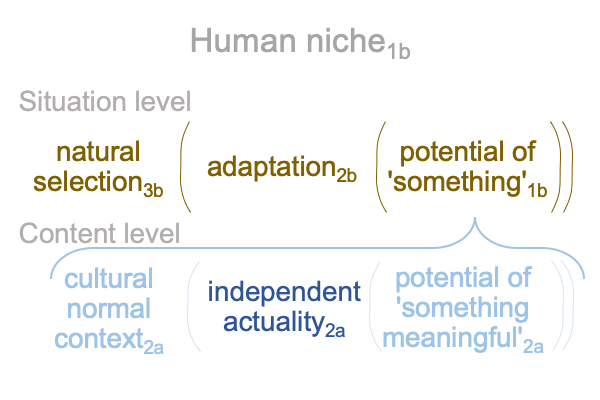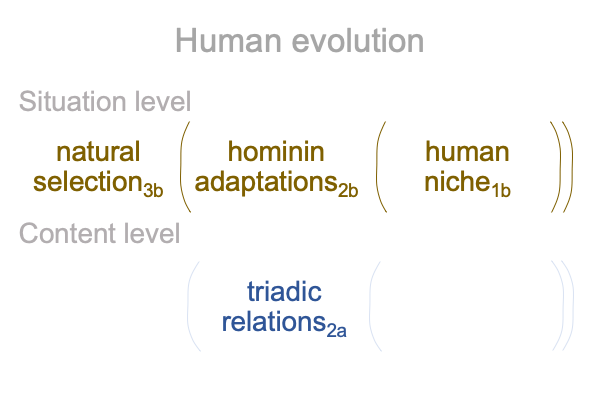0007 Okay, if the word, “niche” labels the possibility of ‘something’1, then what is this so-called ‘something’?
Now, I turn to A Primer on Sensible and Social Construction (by Razie Mah, available at smashwords and other e-book venues).
‘Something’ is a content-level actuality2a that is independent of the adapting species.
Consequently, the niche1b is the situation-level potential1b that virtually emerges from (and situates) a content-level actuality2a that is independent of the adapting species.

0008 The most notable feature of this sensible construction is that the content-level actuality2a has no apparent normal context3a or potential1a. In order to understand this actuality2a, one must ascertain its normal context3a and potential1a, which is a very difficult assignment.
Perhaps, this difficulty is why modern biologists say that the actuality2a reflects environmental or ecological conditions. Well, “conditions” also has the advantage of implying a specific material ‘something’ that a species adapts to. Such specificity implies that all niches are proximate.
0009 When the authors use the term, “niche switching”, they are saying that humans are adapted to flourishing in a wide-variety of ecologies and environments.
How do humans accomplish this flourishing?
Well, the generalist within us solves problems. The specialist within us modifies a skill set. Consciousness (or, is it culture?) is adaptive because it draws out an understanding that a content-level actuality3a has a normal-context3a and a potential1a that the person (along with others) can adapt2b to. In other words, the content-level independent actuality2a is meaningful.

0010 There is another advantage of a category-based depiction of Darwinian evolution. It explains the idea of niche construction.
Niche construction occurs when a situation-level adaptation2b alters the content-level actuality2a by introducing a content-level normal context2a and potential1a. To a beaver, a rapidly moving stream surrounded by woods2a has the normal context3a of a place to settle3a and the potential1a of damming the creek to make a home1a. Once this happens, once beavers down enough trees to block the water’s free flow, the independent actuality2a becomes a slow moving creek and glen2a.
Humans are even more sophisticated, since the independent actuality2a becomes meaningful. Our lineage adapts to a niche1b, where the potential of understanding comes from converting an actuality2a into a sign, a mediation, a category-based nested form or some other triadic relation. The sign-relation has three elements: sign-vehicle, sign-object and sign-interpretant. The mediation has three elements: matter, form and mediator. The category-based nested form has three elements: normal context3, actuality2 and potential1. The subscripts refer to the three categories detailed by American philosopher, Charles Peirce: thirdness, secondness and firstness, respectively.
0011 Triadic relations are real (although immaterial) beings (that entangle the material world). Until recently, no biologist imagines that these ephemeral beings could compose an actuality independent of an adapting species2a. Yet, many biologists suggest that the human niche consists of niche construction, or, as with these authors, “niche switching”.
The hypothesis that the ultimate human niche is the potential of triadic relations appears in Razie Mah’s e-book, The Human Niche. The hypothesis is tested in four commentaries.
Comments on Steven Mithen’s Book (1996) The Prehistory of Mind
Comments on Derek Bickerton’s Book (2014) More that Nature Needs
Comments on Clive Gamble, John Gowlett and Robin Dunbar’s Book (2014) Thinking Big
Comments on Robert Berwick and Noam Chomsky’s Book (2016) Why Only Us?
All are available at smashwords and other e-book venues. They are listed in the series: A Course on the Human Niche.
0012 Here is a diagram of Darwinian evolution for the Homo genus.

